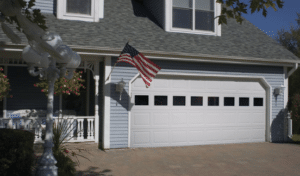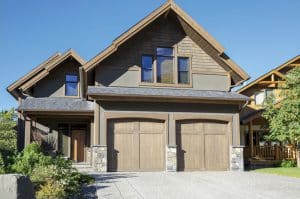Topics Covered:
When was the last time you thought about the seal around your garage door—or around the garage itself? If your answer is “not recently,” you’re not alone. While homeowners frequently focus on major components like openers or springs, the simple act of weather sealing your garage can have a tremendous impact on everything from comfort and energy efficiency to the overall condition of your belongings.
What Is Weather Sealing, and Why Does It Matter?
To put it simply, weather sealing (or weatherstripping) involves creating barriers—usually rubber, vinyl, or foam—that prevent outside air, water, dust, and pests from sneaking into your garage. You’ll find these seals along the bottom edge of the door, around the sides, and sometimes at joints between panels or walls.
Why bother? Because a poorly sealed garage can lead to:
- Excessive Moisture: Rainwater or snowmelt entering the garage can cause everything from mold growth to rusted tools.
- High Utility Bills: If your garage is attached to your home, temperature fluctuations in that space can drive up heating and cooling costs.
- Drafts and Uncomfortable Temperatures: A cold breeze or hot draft blowing under your garage door isn’t pleasant—especially if you use the space as a workshop or storage area.
- Pest Intrusions: Mice, insects, and other critters look for easy access points. A worn seal can be an open invitation.
Ultimately, proper weather sealing is about preserving both the integrity of your garage and the comfort of your home. It’s a small investment with surprisingly big payoffs.
Key Areas That Need Weather Sealing
When you think of garage weather sealing, the door itself is usually the first thing that comes to mind. But that’s just one piece of the puzzle. Here are the primary spots you’ll want to inspect:
- Garage Door Bottom Seal: This flexible strip runs along the bottom edge of the door, forming a tight barrier against the ground. If it’s cracked or missing pieces, water, air, and pests can easily enter.
- Side and Top Seals: Sometimes called doorstop molding, these strips line the outer edges of the door, blocking gaps where daylight might peek through.
- Threshold Seal (Floor-Mounted): This is a raised strip adhered to the garage floor directly under the door’s bottom edge. It acts as a mini-barrier for garages prone to water runoff or uneven floors.
- Windows and Doors (If Present): If your garage has side-entry doors or windows, check the weatherstripping around those, too. Gaps around frames can undermine all your other sealing efforts.
- Wall and Ceiling Penetrations: Spots where pipes, ducts, or cables enter the garage can be sealed with foam or caulk to keep out drafts and bugs.
Each of these areas can let in the elements if not sealed properly. A thorough check—especially during seasonal transitions—can reveal small issues before they morph into bigger headaches.
How Weather Sealing Shields Your Garage from Rain and Moisture
Nothing ruins a garage faster than unchecked moisture. Whether from driving rain, melting snow, or even high humidity, moisture can damage your belongings and lead to mold growth. Here’s how proper sealing defends against water intrusion:
- Sealed Bottom Edge: When your garage door closes, a fresh, flexible seal presses against the floor, effectively blocking water from running in under the door.
- Overlap and Compression: Side and top seals are often designed to overlap the door’s edges. This overlap plus compression keeps wind-driven rain from sneaking in at the sides.
- Thresholds and Channels: In some systems, threshold seals have a small built-in channel that helps direct water away, ensuring it runs off to the sides rather than pooling in the garage.
By keeping rainfall at bay, you protect not only your car and stored items, but also the structure of your garage itself. Water infiltration can rot wood framing or lead to corrosion in metal components—a costly fix down the line.
Temperature Control and Energy Efficiency
While your garage may not be fully climate-controlled, temperature swings in that space can still affect your home’s HVAC system—particularly if the garage is attached or shares air ducts with living areas. Here’s how weather sealing helps maintain a more stable interior climate:
- Minimizing Air Leakage: In winter, a poorly sealed garage door can let in cold drafts that seep into rooms above or adjacent to the garage. In summer, that same gap allows hot, humid air to invade.
- Less Stress on Your Heater or AC: When the garage isn’t drastically hotter or colder than the rest of your home, it’s easier for your HVAC to maintain the temperature you want in your living spaces.
- Opportunity for Additional Insulation: Along with sealing, consider insulating your garage door and walls. The combination of insulation and airtight sealing can really cut down on energy costs.
Even if you don’t spend much time in the garage, you’ll likely see the difference in your monthly utility bills. And if you do use the garage as a workshop, home gym, or hobby area, you’ll appreciate the improved comfort.
Keeping Bugs and Rodents at Bay
If you’ve ever walked into your garage and found unexpected visitors—like spiders, roaches, or mice—you’re not alone. Garages often contain tempting nesting spots, especially if they’re cluttered or if you store pet food or birdseed. Weather sealing plays a big role in pest prevention:
- Tight Bottom Seal: Many rodents can squeeze through openings as small as a quarter-inch. A snug door seal reduces those opportunities significantly.
- Side and Corner Coverage: Gaps near the corners or along the sides are common entry points for insects and critters. Ensuring the seals meet properly at these junctions is key.
- Less Food Debris: By blocking outside air, you also reduce the flow of smells that might attract pests, helping keep them disinterested in your garage in the first place.
It’s worth noting that if you have a persistent pest problem, you may also need to check other potential gaps (like around pipes or vents) and keep the garage tidy. But weather sealing is often the first line of defense.
Telltale Signs of Worn-Out Weather Seals
Even if you installed a great seal initially, time and the elements eventually take their toll. Look for these warning signs:
- Cracks or Tears in the Rubber/Vinyl: Physical damage is an obvious sign it’s no longer forming a tight barrier.
- Daylight at the Door’s Edges: If you see rays of sunshine poking through gaps when the garage is closed, that’s a red flag.
- Water Stains or Puddles: After a rainstorm, check the interior near the door’s threshold for damp spots.
- Drafts or Temperature Swings: Feel a breeze near the door, or notice the garage becomes quickly cold or hot? Your seal might be letting in outside air.
- Pest Evidence: If you see droppings, gnaw marks, or spider webs near potential gaps, your seal is likely compromised.
Catching these issues early can save you from bigger problems later, so a quick inspection every few months—especially after extreme weather—is time well spent.
Types of Weather Seal Materials
When replacing or upgrading your garage door seals, you’ll find a variety of material options:
- Rubber (EPDM or Neoprene): Flexible, durable, and well-suited for temperature extremes. Often used on the bottom edge of the door.
- Vinyl: Common for side or top seals. Also quite flexible and decent at handling moisture, though some vinyl can become brittle after long sun exposure.
- Foam Tape: Used mostly around windows or door frames. Easy to apply but less robust than rubber or vinyl for large gaps.
- Brush Seals: Instead of solid rubber, brush seals feature a set of bristles that block out dust and insects. They’re less common for residential garages but can be effective for certain setups.
We generally recommend rubber-based seals for the bottom edge, thanks to their durability and good contact with the floor. Vinyl side seals also hold up well in Raleigh’s mixed climate, offering reliable performance year-round.
DIY vs. Professional Weather Sealing
You may wonder if you can handle garage door weather sealing on your own. The answer depends on your comfort level with basic tools and whether your door has any unique quirks.
- DIY Approach:
- Pros: Can be cost-effective if you find a compatible seal kit and do it properly. Good for minor touch-ups or small gaps.
- Cons: Requires accurate measuring and cutting. An improperly fitted seal can still leave gaps. Also, dealing with an unbalanced or misaligned door might be beyond many DIYers.
- Professional Installation:
- Pros: Ensures a perfect fit, addresses underlying door or track issues, and often comes with a workmanship warranty. You also get tips on ongoing maintenance.
- Cons: Slightly higher upfront costs, but often pays off in quality and peace of mind.
If your door has major alignment problems or you’re not sure which seal type suits your specific track or threshold, we recommend consulting an expert. It’s often quicker (and ultimately cheaper) than trial-and-error.
Maintenance Tips for Longevity
Once you’ve got new seals in place, a little TLC helps them last:
- Clean the Seals Periodically: Wipe away dirt, dust, or dead leaves. Grit can accelerate wear.
- Check for Cracks or Dry Rot: Over time, rubber can become brittle. Inspect it at least twice a year—like at the start of summer and winter—and replace if you see damage.
- Ensure Door Tracks and Springs Are in Good Condition: An unbalanced door that drags on one side can prematurely wear out the seal.
- Use Lubricants Wisely: Some installers suggest a light application of silicone-based lubricant on the seal to keep it flexible, but check your manufacturer’s guidelines first.
With straightforward maintenance, a quality seal can often provide a tight barrier for years, keeping your garage cozier and cleaner.
How RJ Garage Door Services Can Help
Here in Raleigh, we’ve tackled every imaginable garage weather sealing scenario—from older wooden doors to sleek modern steel ones. At RJ Garage Door Services, we pride ourselves on:
- Expert Assessment: We don’t just slap on a seal. We inspect your door’s condition, floor level, and any existing alignment issues to pick the best sealing strategy.
- Quality Materials: We use tried-and-tested products that can handle Raleigh’s temperature swings and humidity, giving you a longer-lasting result.
- Professional Fit: Our technicians measure carefully and trim seals to ensure uniform contact with the ground, preventing the dreaded “light leaks.”
- Transparent Pricing: No hidden fees or inflated bills. We walk you through the costs so you know exactly what you’re paying for.
Whether you’ve got a small one-car setup or a big multi-bay garage, we’ll tailor the solution to match your door type, floor surface, and budget. Our goal is always the same: to keep the elements out and your garage comfortable.
Parting Thoughts
At first glance, weather sealing might seem like a minor detail in the grand scheme of home maintenance. But let it slip, and you’ll see how quickly drafts, moisture, and pests can undermine your comfort, damage stored items, or even impact your energy bills. On the flip side, a simple investment in sealing can transform your garage into a more usable, safer, and cost-efficient space.
Remember the signs: visible gaps, drafts, pest problems, or water leaks all point to a compromised seal. Staying on top of replacements and repairs goes a long way toward keeping your garage—and by extension, your home—in top-notch shape. And if you ever feel unsure about what seal to choose or how to install it, the RJ Garage Door Services crew is just a call away, ready to help you weatherproof your space.
After all, no one wants to come home to a soaked or chilly garage. By properly sealing every nook and cranny, you can safeguard your property from the elements, enjoy lower energy costs, and experience a garage that’s both inviting and well-protected—no matter what Mother Nature throws at it.




